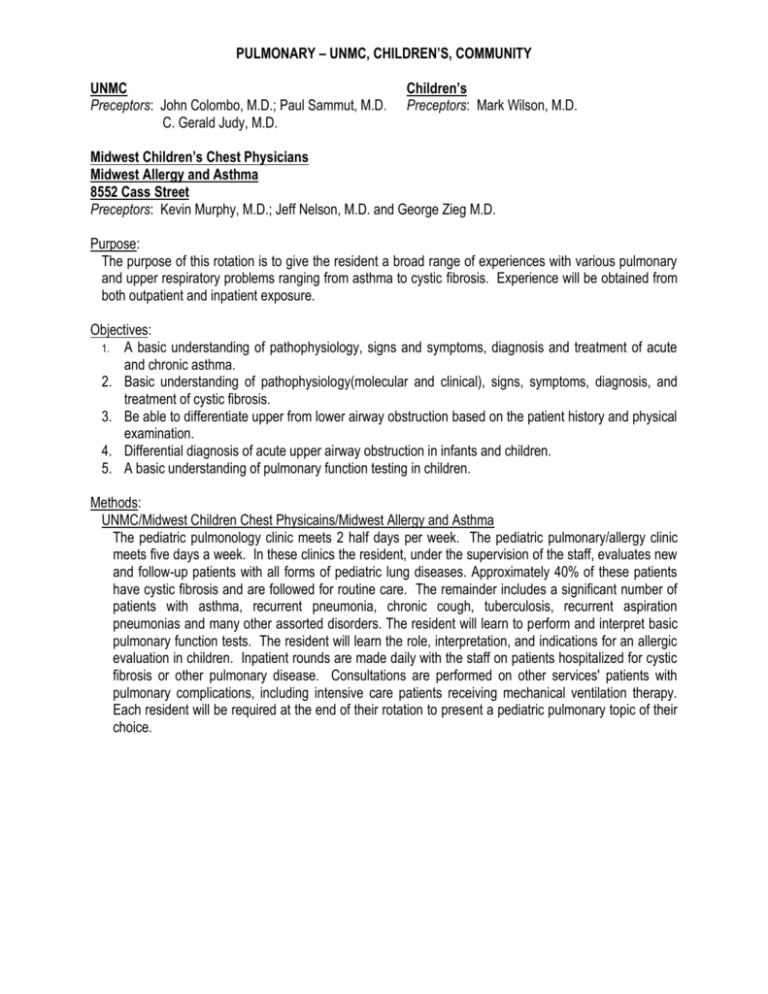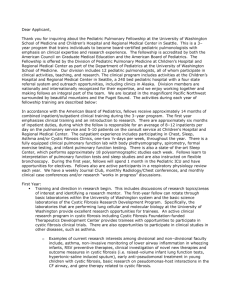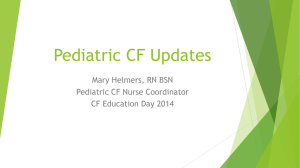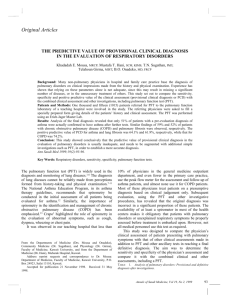pulmonary
advertisement

PULMONARY – UNMC, CHILDREN’S, COMMUNITY UNMC Preceptors: John Colombo, M.D.; Paul Sammut, M.D. C. Gerald Judy, M.D. Children’s Preceptors: Mark Wilson, M.D. Midwest Children’s Chest Physicians Midwest Allergy and Asthma 8552 Cass Street Preceptors: Kevin Murphy, M.D.; Jeff Nelson, M.D. and George Zieg M.D. Purpose: The purpose of this rotation is to give the resident a broad range of experiences with various pulmonary and upper respiratory problems ranging from asthma to cystic fibrosis. Experience will be obtained from both outpatient and inpatient exposure. Objectives: 1. A basic understanding of pathophysiology, signs and symptoms, diagnosis and treatment of acute and chronic asthma. 2. Basic understanding of pathophysiology(molecular and clinical), signs, symptoms, diagnosis, and treatment of cystic fibrosis. 3. Be able to differentiate upper from lower airway obstruction based on the patient history and physical examination. 4. Differential diagnosis of acute upper airway obstruction in infants and children. 5. A basic understanding of pulmonary function testing in children. Methods: UNMC/Midwest Children Chest Physicains/Midwest Allergy and Asthma The pediatric pulmonology clinic meets 2 half days per week. The pediatric pulmonary/allergy clinic meets five days a week. In these clinics the resident, under the supervision of the staff, evaluates new and follow-up patients with all forms of pediatric lung diseases. Approximately 40% of these patients have cystic fibrosis and are followed for routine care. The remainder includes a significant number of patients with asthma, recurrent pneumonia, chronic cough, tuberculosis, recurrent aspiration pneumonias and many other assorted disorders. The resident will learn to perform and interpret basic pulmonary function tests. The resident will learn the role, interpretation, and indications for an allergic evaluation in children. Inpatient rounds are made daily with the staff on patients hospitalized for cystic fibrosis or other pulmonary disease. Consultations are performed on other services' patients with pulmonary complications, including intensive care patients receiving mechanical ventilation therapy. Each resident will be required at the end of their rotation to present a pediatric pulmonary topic of their choice. Children’s Hospital The resident will participate in the care of the hospitalized pediatric patient. The acuity of the illness, the impact on the family, and the impact on the child make the care of the patient a multi-tiered task. The resident on this rotation will assume primary responsibility for their patients, working with the attending to ensure that quality and timely care is given. The resident will continue to advance their communication, clinical problem solving and procedural skills, and become more familiar with common health problems in pediatrics. Implementation: Competencies residents are expected to achieve: 1. Evaluate patients from infancy through adolescence in a variety of clinical settings, establishing rapport with the patient and family in order to obtain a complete history and physical examination. Effectively communicate information to both the patient and parent, ensuring both understand the diagnosis and treatment plan and have the opportunity to ask questions. Recognize the important role of patient education in management of acute and chronic illnesses. 2. Prepare a complete written summary of the history and physical. Present a complete, well organized summary of the findings of the patient's history and physical examination, modifying the presentation to fit the situation. 3. Identify clinical problems and formulate an initial diagnostic and therapeutic plan, considering the cost, risks, benefits and limitations of laboratory tests, imaging studies, medications, consultations. Write admission orders for the hospitalized patient. 4. Effectively communicate information about the diagnosis and treatment to the patient and caregiver. Communicate with other health care workers, including consultants, nurses and social workers. 5. Interpret the results of commonly ordered laboratory tests, such as the CBC, urinalysis, and serum electrolytes, and recognize that the normal values of some tests may vary with the age of the patient. Write daily progress notes on the patients, including the interpretation. 6. Obtain up-dated information relevant to the diagnosis and treatment of the patient, performing a literature search and critical review of the literature. 7. Understand the indications for procedures such as a lumbar puncture, parenteral fluids including intravenous and intra-osseous fluids, and emergency procedures such as intubation. Provide emotional support for patients undergoing procedures. The technical aspects of the procedures should be introduced, although there is no expectation of mastery at the fourth year student level. Suggested readings: 1. Kendig’s Disorders of the Respiratory Tract in Children, Chernick and Boat, W.B. Saunders, 1998. 2. Pediatric Respiratory Disease: Diagnosis and Treatment, Hilman, W.B. Saunders, 1993. 3. Guidelines for the Diagnosis and Management of Asthma. Expert Panel Report, Clinical Practice Guidelines, National Institute of Health, National Heart, Lung and Blood Institute, United Health Publication Number 97-4051, April 1997. 4. Cystic Fibrosis Lung Disease: Approaching the 21st Century, A certified continuing medical education resource, Thomas M. Murphy, M.D. and Beryl J. Rosenstein, M.D., October 1995 (A copy of which Gary Beck has for distribution to medical student on the general pediatric service). 5. Seminars in Respiratory and in Critical Care Medicine: Cystic Fibrosis, Stanley B. Fiel, M.D., Volume 15; Number 5, September 1994 (For additional reading concerning cystic fibrosis). 6. Acute Infections Producing Upper Airway Obstruction; Roni Grad, M.D., Kindeg’s Disorders of the Respiratory Tract in Children, 6th Edition 1998, pp 447 - 461. Evaluation: 1. The attending staff physicians on service will complete resident evaluation. 2. The staff attending will review daily progress notes, and procedures that the resident completes during the rotation.





